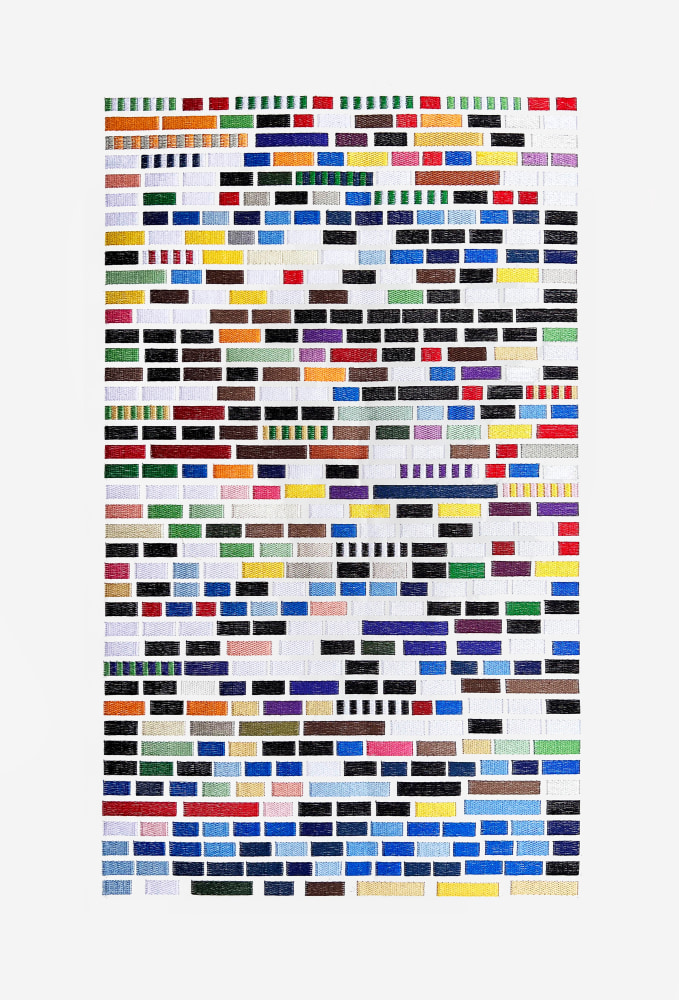
The Huest Eye, 2023-2024
Embroidered thread on Rives BFK paper
36 x 24 in. (91.4 x 61 cm)
Edition of 12
Published by Goya Contemporary / Goya-Girl Press
Sonya Clark: The Huest Eye and The Bluest, Twisted
Sonya Clark’s two editions, The Huest Eye and The Bluest, Twisted, center around the seminal writing of Toni Morrison’s groundbreaking novel The Bluest Eye, published in 1970. The artist has read and reread the book more than thirty times. Utilizing embroidery and lithography techniques, these two stunningly striking editions examine a complex dialogue that centers Blackness in America and redresses society’s constructed ideals of beauty in relation to internalized racism.
In her writing, Toni Morrison—one of the 20th century’s most influential writers and intellectuals-- challenges the discriminatory, socially constructed myths of Western beauty paradigms which privilege Whiteness above Blackness. The book centers the negative impact these destructive falsehoods have on society and its most vulnerable members. Set in Lorain, Ohio in the 1940’s, The Bluest Eye tells the story of Pecola Breedlove, a young black child negotiating life and navigating the racism and violence in America while persistently pursuing “beauty.”
Morrison's metaphorical and symbolic use of color in this book is profound, and Clark positions the 473 colors referenced by Toni Morrison into blocks of vibrant, embroidered thread that act as visual stand-ins for each color in the text. As Clark explains: “In The Huest Eye the colors follow the order in which they appear in the writing. The length of each color block corresponds to the length of the word. Red is a short block, whereas purple is longer. I did the green and white together in some places, as this is where Morrison refers to the Dick and Jane stories, which commingle into compressed, unseparated words as the novel progresses.” Clark goes on to explain that the entire piece “is meant to correspond with The Bluest, Twisted as a solid mass. And of course, if you mixed all those referent colors together, one would arrive at black.”
“It is key that the colors are embroidered on paper to highlight the relationship between text and textile,” said Clark. “The Bluest, Twisted connects visual representations of hair, the fiber we grow, to text. And it is significant that Toni Morrison died the year the CROWN act was written, in 2019.” The Bluest, Twisted overlays all the pages from The Bluest Eye transliterated into an alphabet (called Twist) that Clark created using her own hair. The Bluest, Twisted builds upon itself to form a black mass of natural hair that, when framed and glazed, becomes a mirror, and reflects the viewer. “It is important the viewer sees themselves in this work,” says Clark. “My font, made in curl pattern of African hair, resists the European dominance of the Roman alphabet’s widespread use. Twist re-centers Africa as the cradle of humanity. It returns us to our roots.”
Published by Goya Contemporary/Goya-Girl Press, and working with one of the most celebrated printmakers in the country, Judith Solodkin of Solo Impression in NY, Clark translates her potent message into meticulously embroidered and printed works that question and bear witness to how we treat each other, and why.
Toni Morrison once said, “If you find a book you really want to read but it hasn't been written yet, then you must write it.” Morrison was intentional about the stories she gifted the world. In a similar way, every aspect of Clark’s two works reaches fruition with extreme intentionality to examine epic themes and disrupt the stronghold of discrimination that is reinforced by routine language, customs, actions, and representations.
Both Morrison’s and Clark’s cultural impact cannot be understated. Like Morrison, Clark credits her ancestors for impacting the tenor of her work, as well as her navigation through the world. Clark was deeply impacted by Morrison’s writing and her activism and considers Morrison a heroic figure of truth and justice.
*All quotes taken from a conversation between Sonya Clark and Amy Raehse, October 2023.
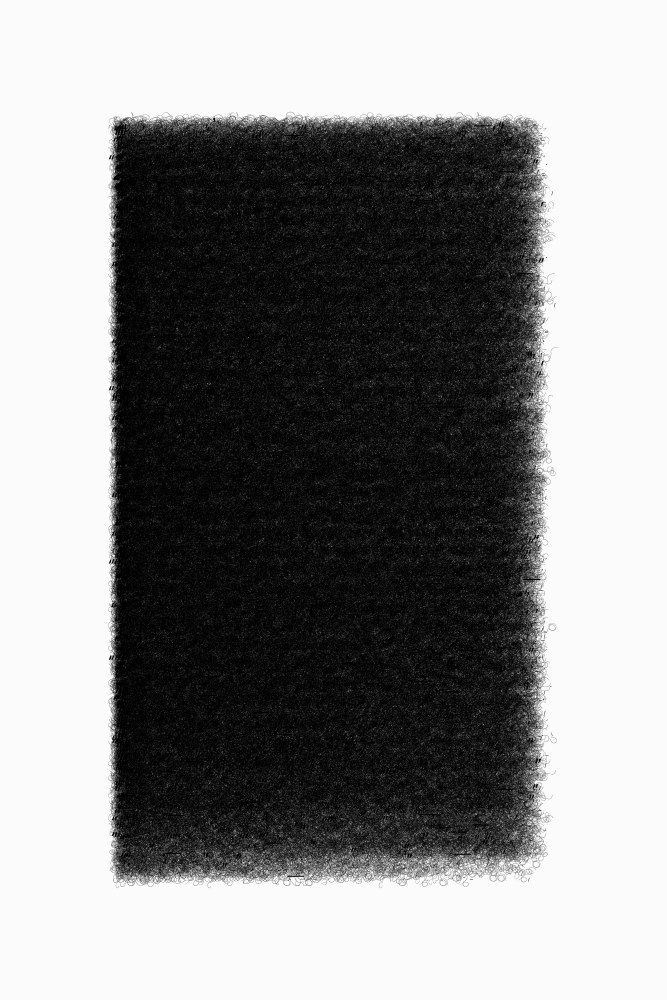
The Bluest, Twisted, 2023-2024
Lithograph on Rives BFK paper
36 x 24 in. (91.4 x 61 cm)
Edition of 30
Published by Goya Contemporary / Goya-Girl Press
Sonya Clark: The Huest Eye and The Bluest, Twisted
Sonya Clark’s two editions, The Huest Eye and The Bluest, Twisted, center around the seminal writing of Toni Morrison’s groundbreaking novel The Bluest Eye, published in 1970. The artist has read and reread the book more than thirty times. Utilizing embroidery and lithography techniques, these two stunningly striking editions examine a complex dialogue that centers Blackness in America and redresses society’s constructed ideals of beauty in relation to internalized racism.
In her writing, Toni Morrison—one of the 20th century’s most influential writers and intellectuals-- challenges the discriminatory, socially constructed myths of Western beauty paradigms which privilege Whiteness above Blackness. The book centers the negative impact these destructive falsehoods have on society and its most vulnerable members. Set in Lorain, Ohio in the 1940’s, The Bluest Eye tells the story of Pecola Breedlove, a young black child negotiating life and navigating the racism and violence in America while persistently pursuing “beauty.”
Morrison's metaphorical and symbolic use of color in this book is profound, and Clark positions the 473 colors referenced by Toni Morrison into blocks of vibrant, embroidered thread that act as visual stand-ins for each color in the text. As Clark explains: “In The Huest Eye the colors follow the order in which they appear in the writing. The length of each color block corresponds to the length of the word. Red is a short block, whereas purple is longer. I did the green and white together in some places, as this is where Morrison refers to the Dick and Jane stories, which commingle into compressed, unseparated words as the novel progresses.” Clark goes on to explain that the entire piece “is meant to correspond with The Bluest, Twisted as a solid mass. And of course, if you mixed all those referent colors together, one would arrive at black.”
“It is key that the colors are embroidered on paper to highlight the relationship between text and textile,” said Clark. “The Bluest, Twisted connects visual representations of hair, the fiber we grow, to text. And it is significant that Toni Morrison died the year the CROWN act was written, in 2019.” The Bluest, Twisted overlays all the pages from The Bluest Eye transliterated into an alphabet (called Twist) that Clark created using her own hair. The Bluest, Twisted builds upon itself to form a black mass of natural hair that, when framed and glazed, becomes a mirror, and reflects the viewer. “It is important the viewer sees themselves in this work,” says Clark. “My font, made in curl pattern of African hair, resists the European dominance of the Roman alphabet’s widespread use. Twist re-centers Africa as the cradle of humanity. It returns us to our roots.”
Published by Goya Contemporary/Goya-Girl Press, and working with one of the most celebrated printmakers in the country, Judith Solodkin of Solo Impression in NY, Clark translates her potent message into meticulously embroidered and printed works that question and bear witness to how we treat each other, and why.
Toni Morrison once said, “If you find a book you really want to read but it hasn't been written yet, then you must write it.” Morrison was intentional about the stories she gifted the world. In a similar way, every aspect of Clark’s two works reaches fruition with extreme intentionality to examine epic themes and disrupt the stronghold of discrimination that is reinforced by routine language, customs, actions, and representations.
Both Morrison’s and Clark’s cultural impact cannot be understated. Like Morrison, Clark credits her ancestors for impacting the tenor of her work, as well as her navigation through the world. Clark was deeply impacted by Morrison’s writing and her activism and considers Morrison a heroic figure of truth and justice.
*All quotes taken from a conversation between Sonya Clark and Amy Raehse, October 2023.
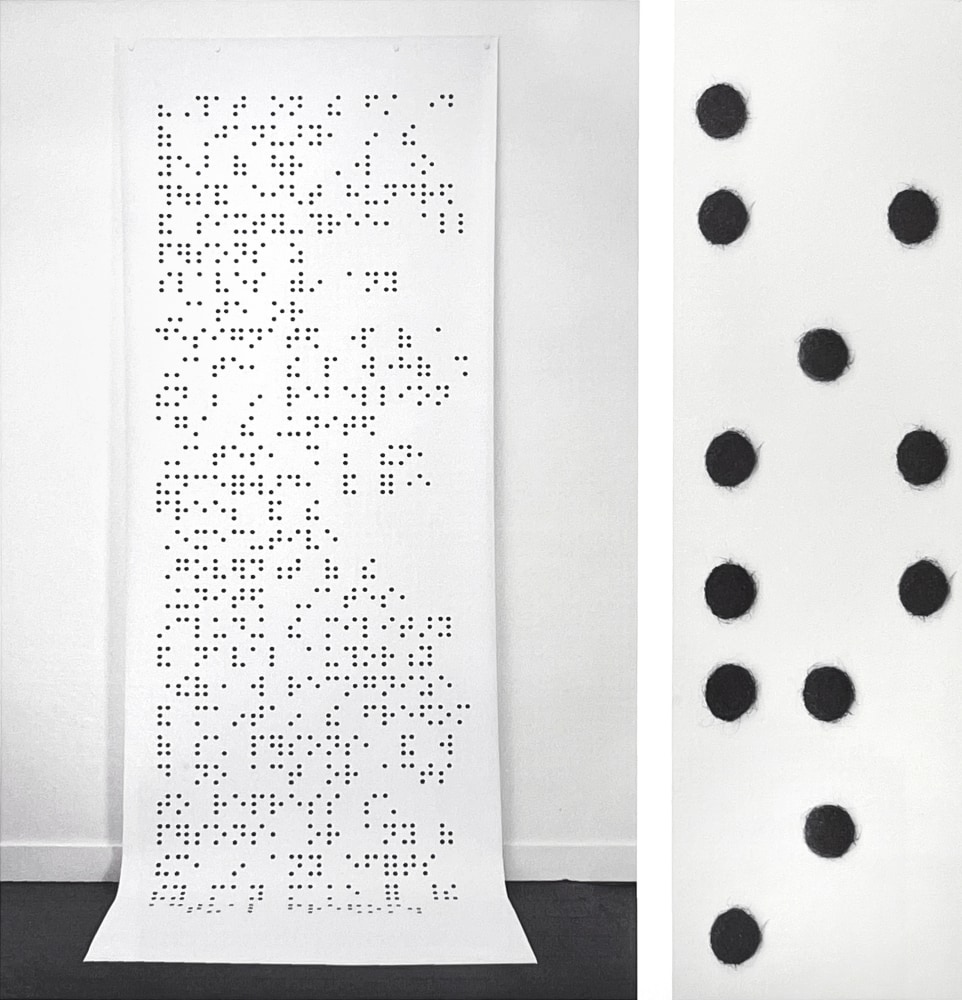
Braille Emancipation, 2011
Archival pigment print
120 x 60 in. (304.8 x 152.4 cm)
Edition 1 of 10
Clar-1062-C
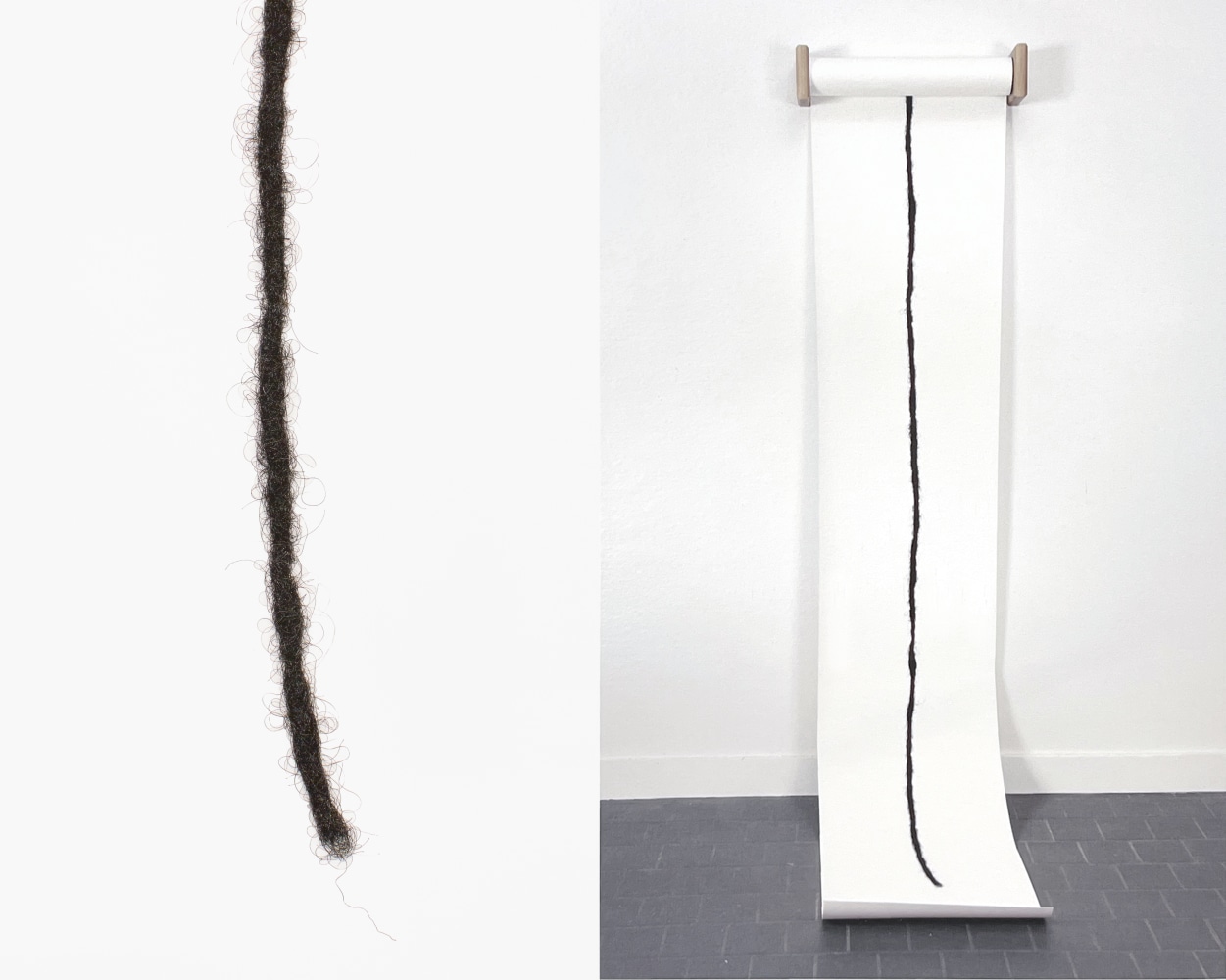
Long Hair, 2005
Archival pigment print and wood
Installed: height variable, up to 120 x 27.5 x 5 in. (304.8 x 69.8 x 12.7 cm)
Edition 1 of 10
Clar-1061-C
Inquire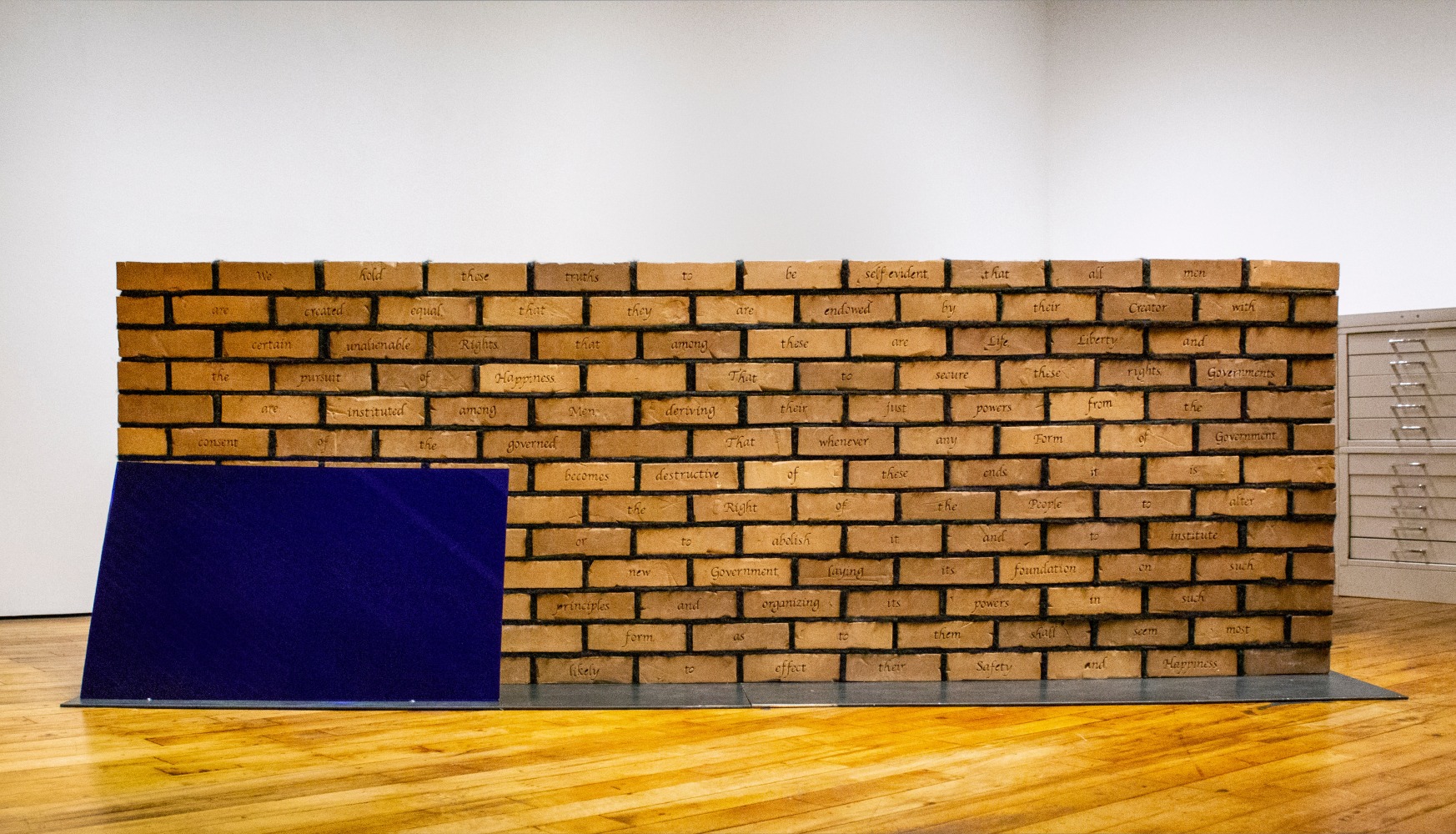
Edifice and Mortar, 2018
Hand stamped bricks, human hair, glass, steel base
39 x 72 x 15 in. (99.1 x 182.9 x 38.1 cm)
Clar-1034-C
Sonya Clark describes Edifice and Mortar as a wall, a flag, and a document that asks us to consider a fundamental question: who laid the foundations of the United States of America?
Each brick is hand-stamped with a traditional maker’s mark and a word. Together the recto forms an excerpt from the Declaration of Independence. The lines of text are interspersed with mortar made from African American hair gathered from Richmond salons—the hair of people whose ancestors might have been legally enslaved and whose life, liberty, and the pursuit of happiness were cut out of Jefferson’s 1776 Declaration. The viscerally charged pointing is meant to represent “black people who are at once held under the weight of the system, but who are also holding this country together.”
The brick stamps display the word Schiavo, which is the origin of the commonly used Italian greeting Ciao. Translated into English, the word Schiavo means SLAVE.
The blue panel is intentionally placed at an angle to reflect the viewer, making each of us a part of the work.
Edifice and Mortar extends Clark’s ongoing material and conceptual reworking of icons of America’s racially divided past and present.
Inquire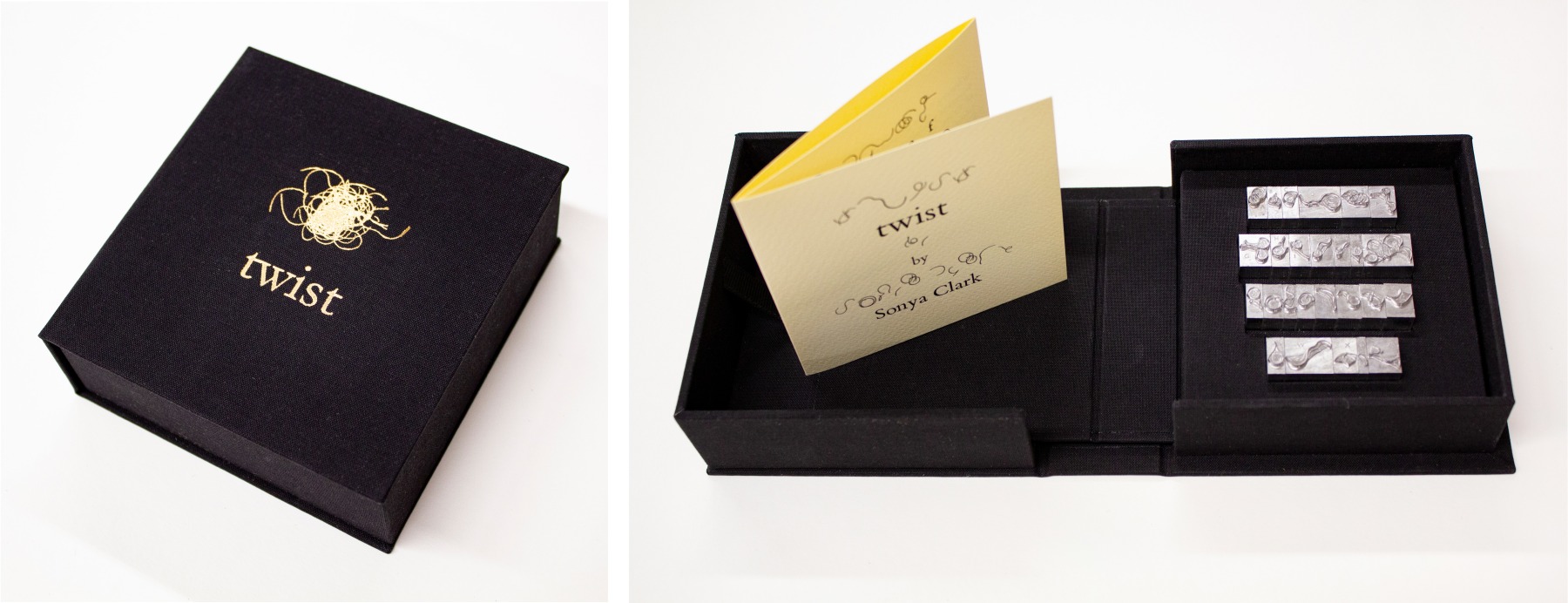
Twist, 2022
Custom portfolio box, metal type, documentation with artist’s signature
Closed: 4 1/2 x 4 1/4 x 1 1/2 in. (11.4 x 10.8 x 3.8 cm)
Open: 4 1/2 x 10 1/8 x 1 1/2 in. (11.4 x 25.7 x 3.8 cm)
Edition of 10
Clar-1060-C
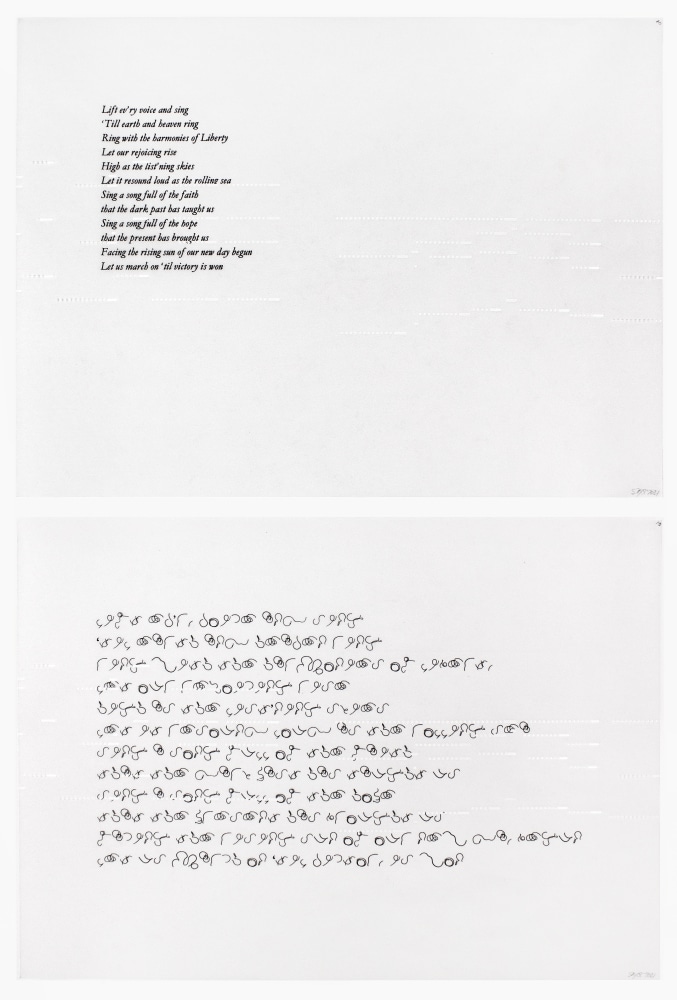
Lift Ev'ry Voice and Sing, 2021
Archival pigment print on perforated piano paper
Diptych, 11 1/4 x 15 in. (28.57 x 38.1 cm) each
Variable edition of 20
Clar-1038-C
"Lift Every Voice and Sing" – often referred to as “the Black national anthem” in the United States – is a hymn written in 1900 as a poem by James Weldon Johnson, and set to music by his brother, J. Rosamond Johnson, for the anniversary of President Abraham Lincoln's birthday. Within this diptych, Clark uses repurposed, perforated piano paper to present the first verse of the lyrics which reads:
“Lift every voice and sing
Till earth and heaven ring
Ring with the harmonies of Liberty
Let our rejoicing rise
High as the listening skies
Let it resound loud as the rolling sea
Sing a song full of the faith that the dark past has taught us
Sing a song full of the hope that the present has brought us
Facing the rising sun of our new day begun
Let us march on till victory is won.”
The second panel repeats the verse using Sonya Clark’s font, invented by the artist using her own hair to shape each letter. At the turn of the 20th century, Johnson's lyrics eloquently captured the solemn yet hopeful appeal for the liberty of Black Americans. Clarks work, like much of her work, redresses history while pointing to the inequalities of the present day.
Inquire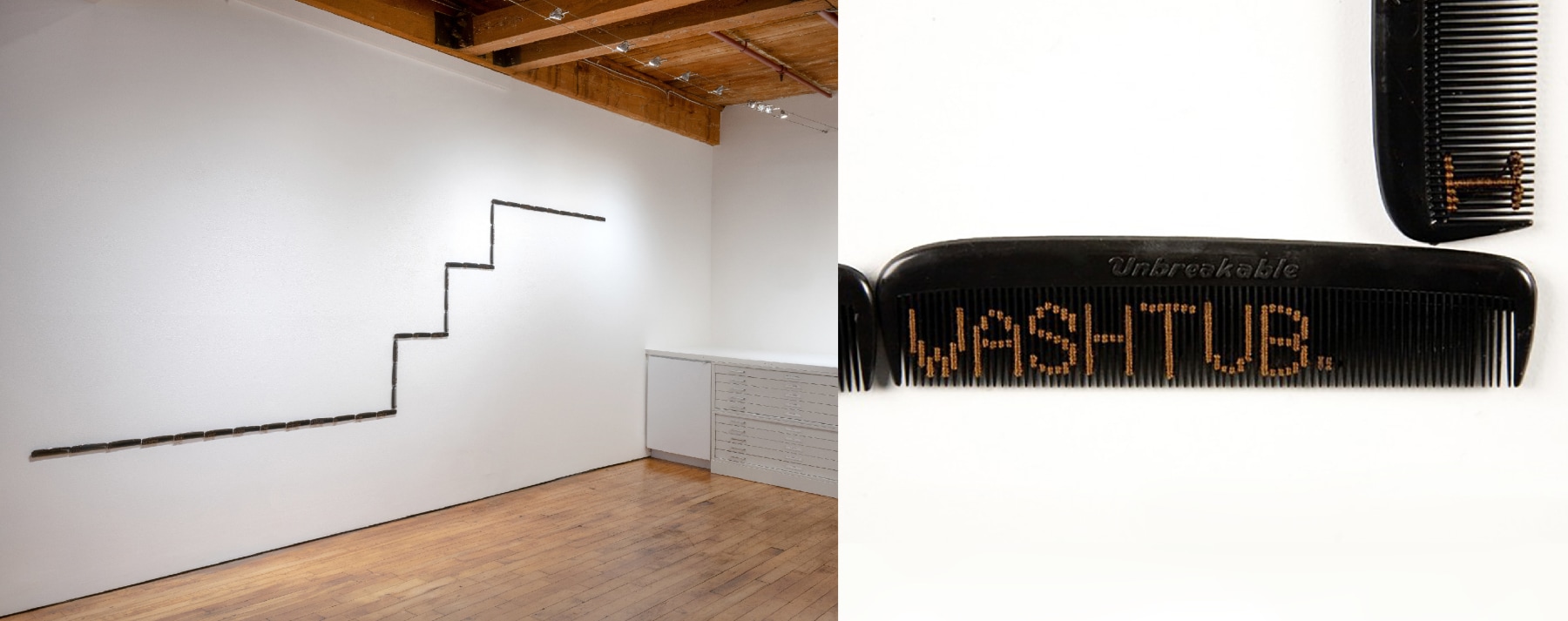
In Her Own Words, 2008
Cast plastic combs, wrapped thread
48 x 144 in. (121.9 x 365.8 cm)
Clar-1013-C
"I am a woman who came from the cotton fields of the south. I was promoted to the washtub.
I was promoted to the kitchen. I promoted myself to the business of hair on my own ground."
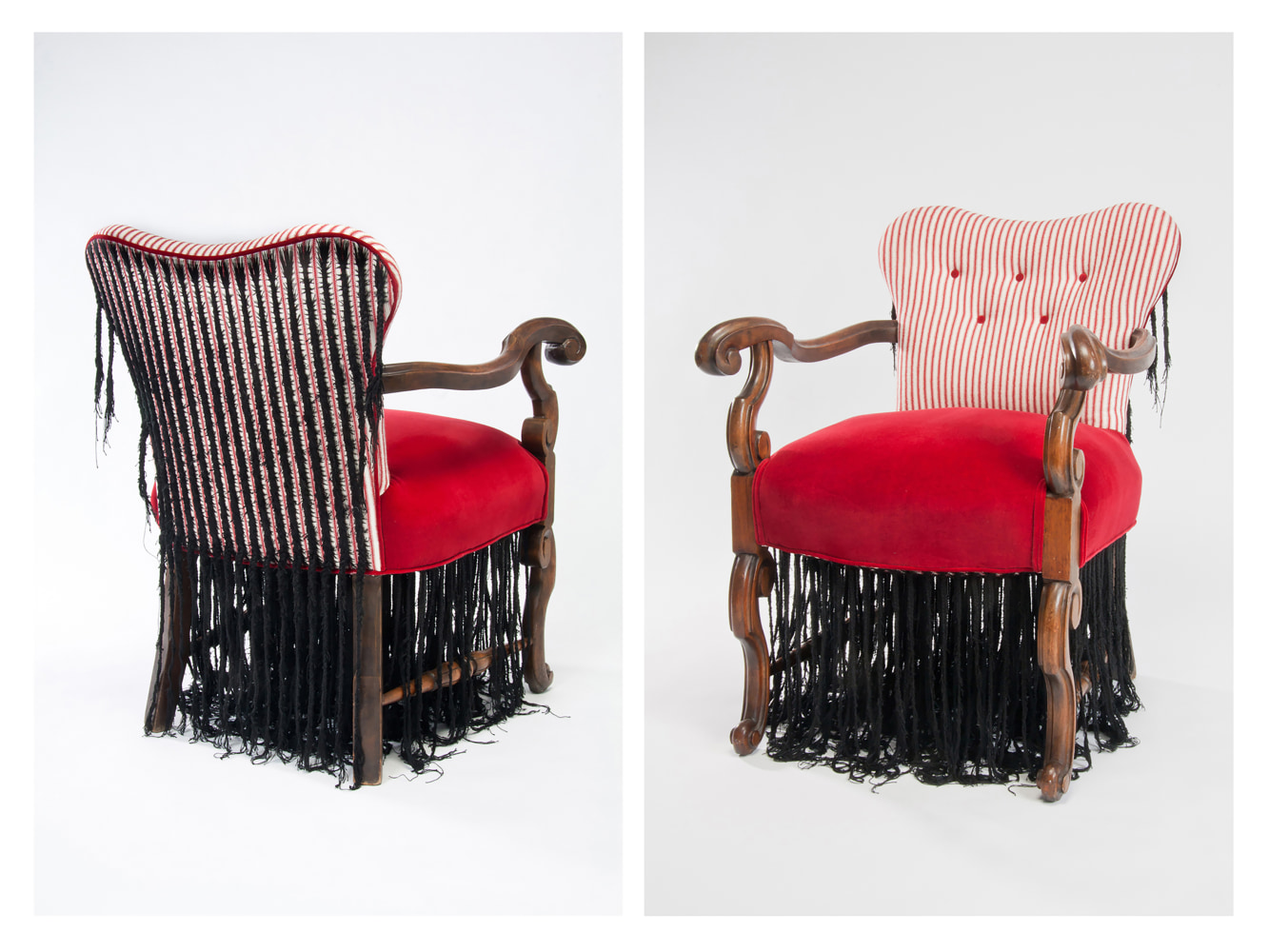
Cornrow Chair, 2011
Upholstered chair, thread, embroidery, braiding
36 x 20 x 20 in. (91.4 x 50.8 50.8 cm)
Collection of Minneapolis Institute of Art, MN
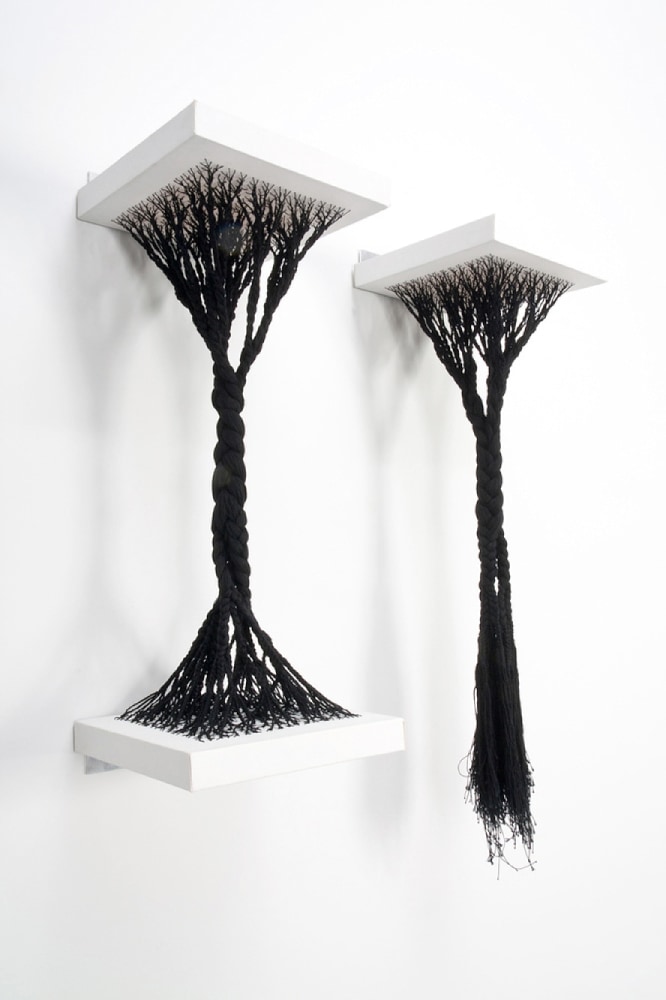
Rooted and Uprooted, 2011
Canvas and thread
30 x 12 x 12 in. (76.2 x 30.48 cm) each
Total size variable per distance apart
Clar-1036-C
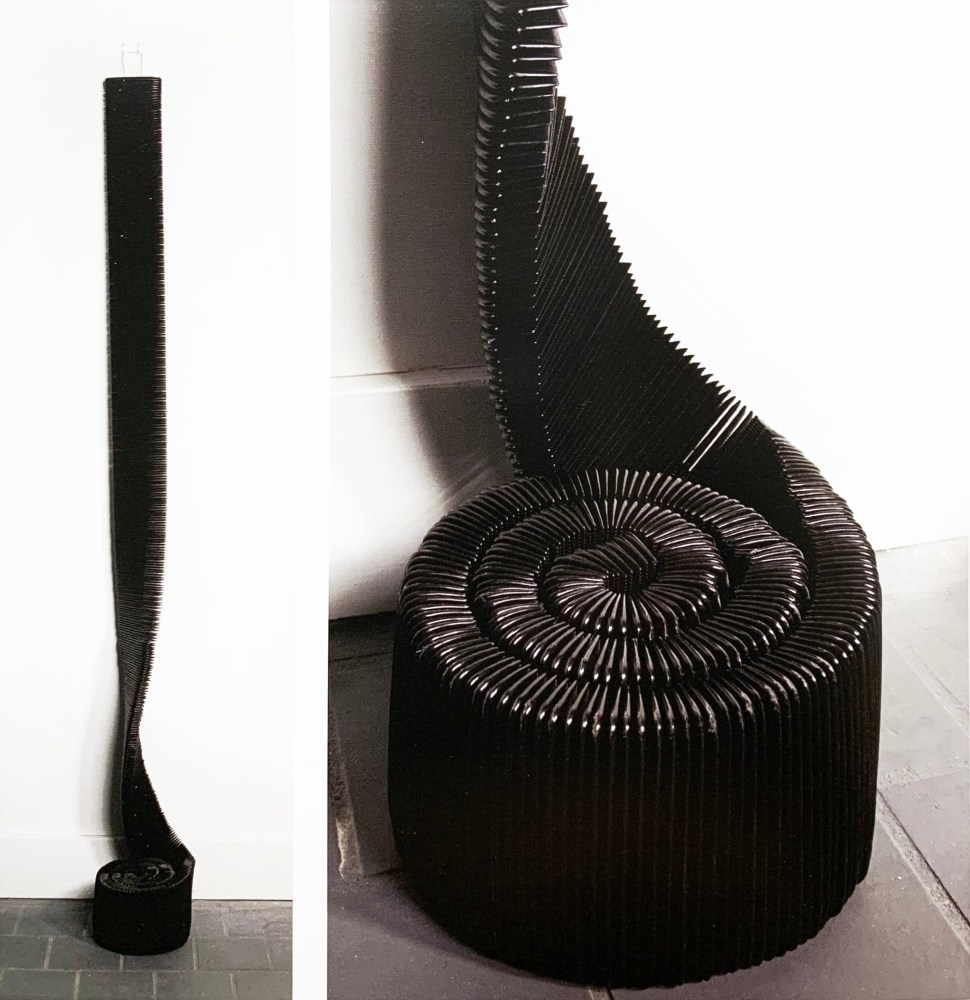
Uncurl, 2009
Plastic combs
90 x 10 x 12 in. (228.6 x 25.4 x 30.48 cm)
Clar-1047-C
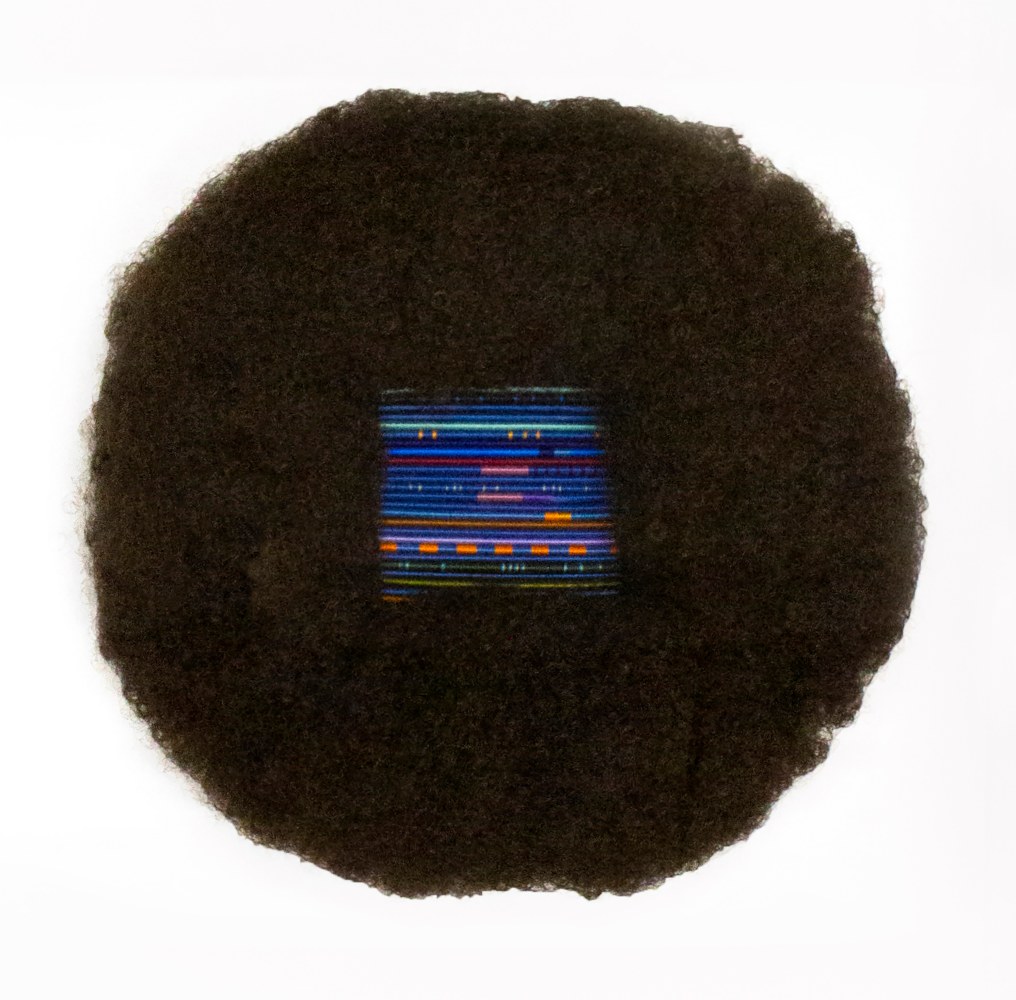
For Colored Girls, A Rainbow, B1, 2019
Wig, cast plastic combs, wrapped thread
12 x 12 x 3 in. (30.5 x 30.5 x 7.6 cm)
Clar-1032-C
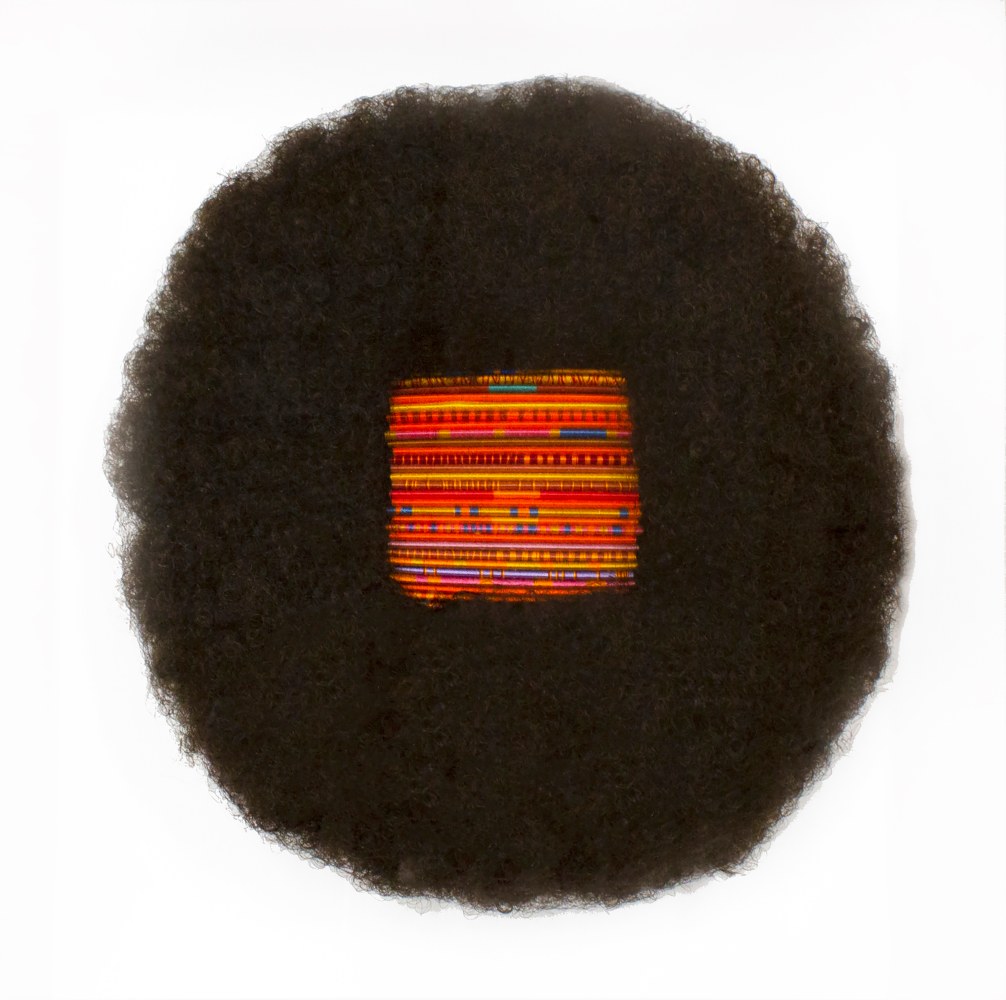
For Colored Girls, A Rainbow, O1, 2019
Wig, cast plastic combs, wrapped thread
12 x 12 x 3 in. (30.5 x 30.5 x 7.6 cm)
Clar-1031-C
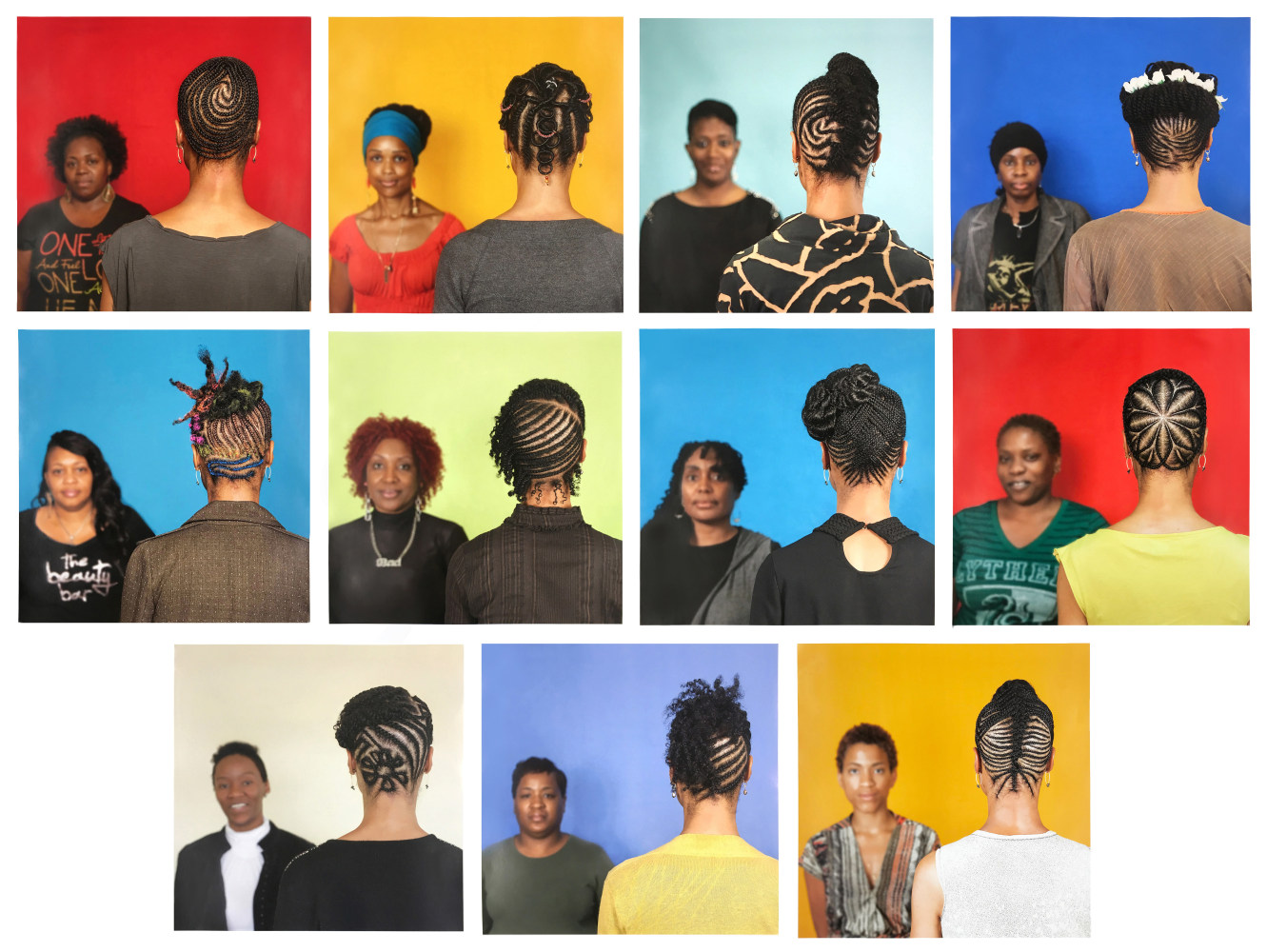
Hair Craft Project, 2014
Series of 11 pigment prints on archival paper
Paper size: 29 x 29 in. (73.7 x 73.7 cm) each
Image size: 26 x 26 in. (66 x 66 cm) each
Edition of 10
Clar-1048 - 1058-C
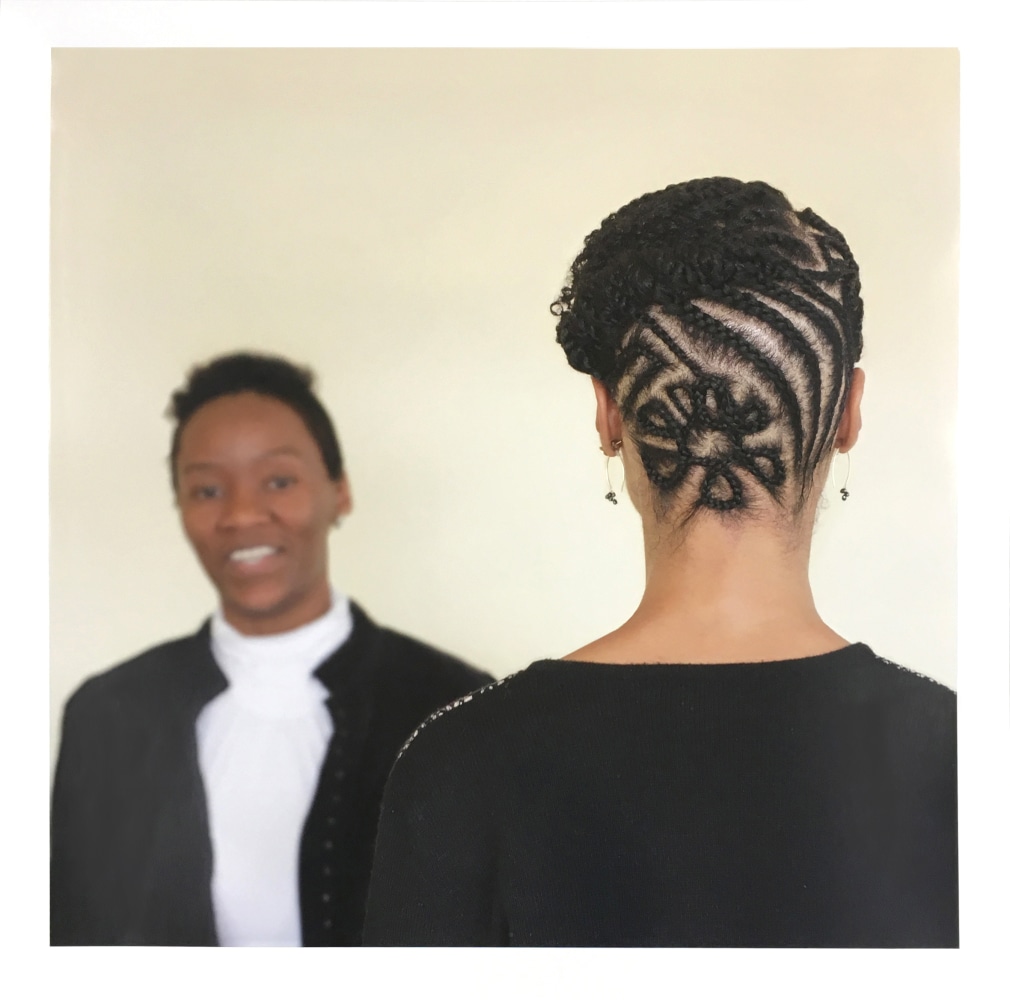
Hair Craft Project with Jasmine and Jameika, 2014
Pigment print on archival paper
29 x 29 in. (73.7 x 73.7 cm)
Edition of 10
Clar-1024-C
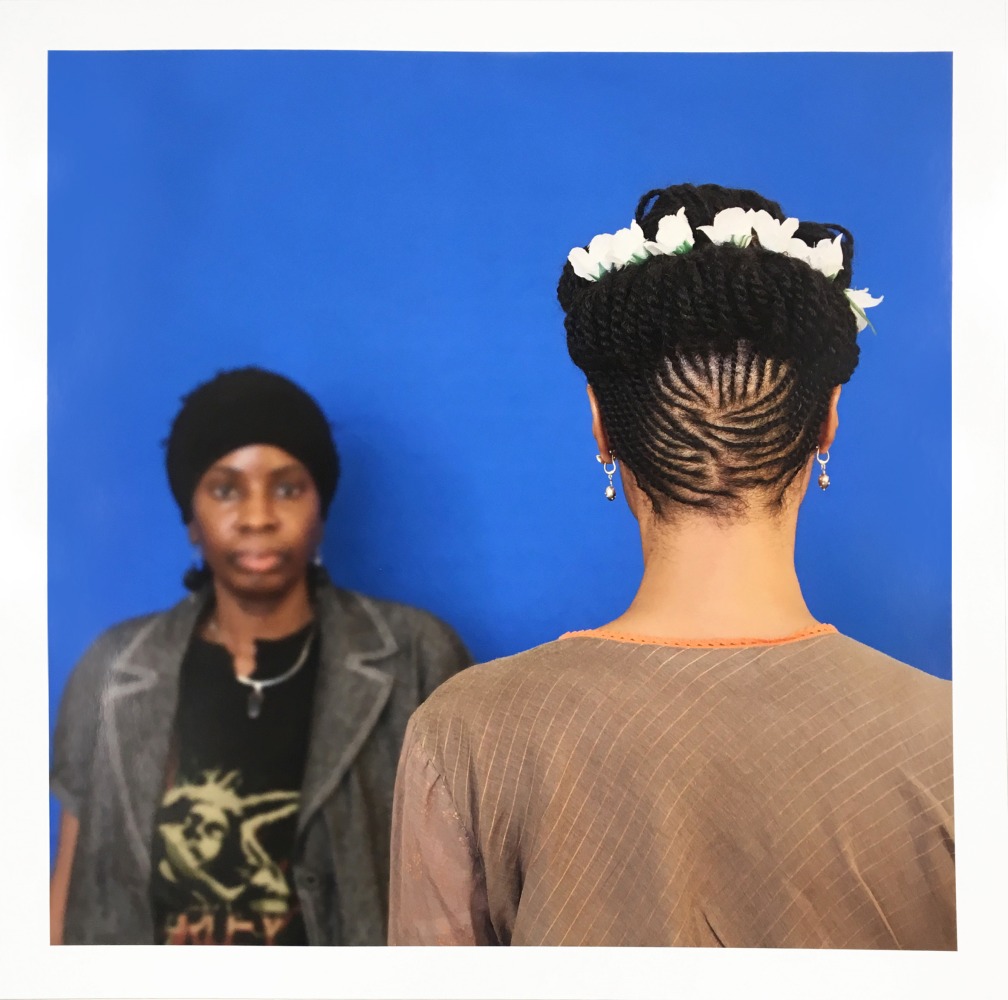
Hair Craft Project with Nasirah, 2014
Pigment print on archival paper
29 x 29 in. (73.7 x 73.7 cm)
Edition of 10
Clar-1023-C
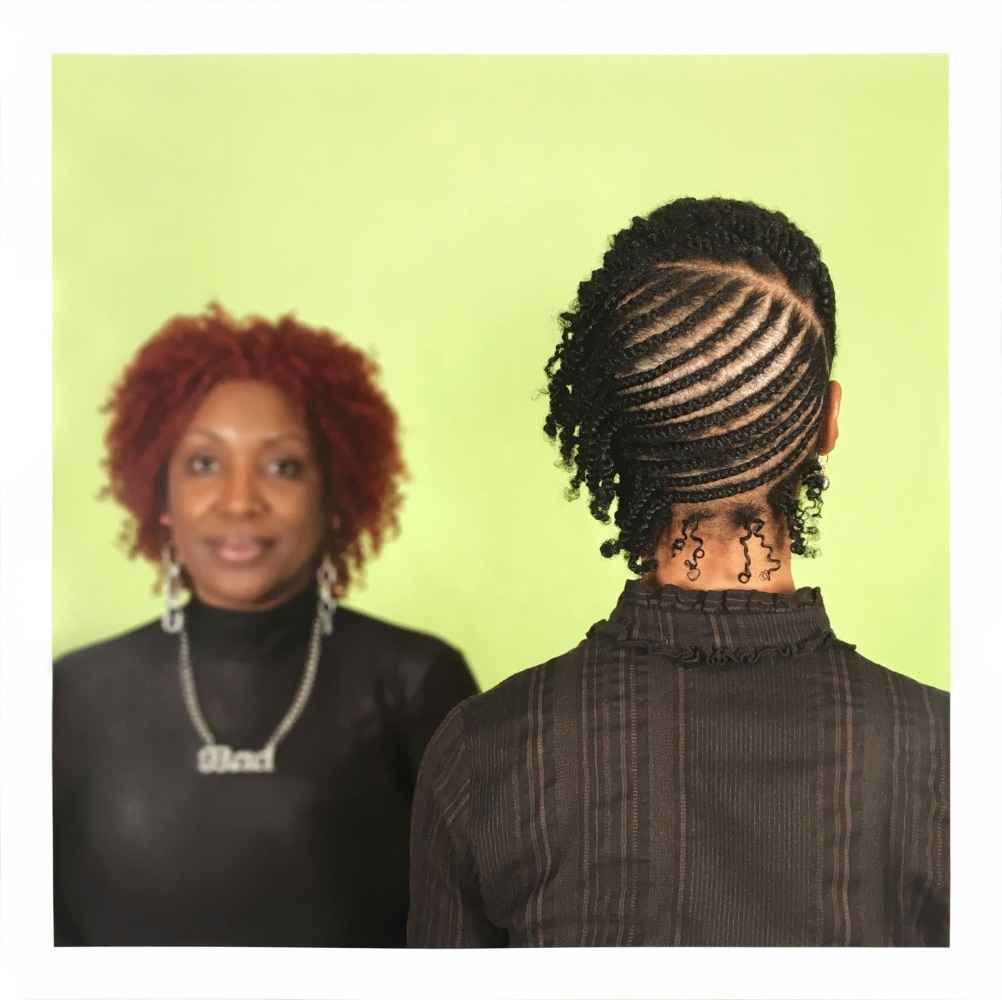
Hair Craft Project with Anita, 2014
Pigment print on archival paper
29 x 29 in. (73.7 x 73.7 cm)
Edition of 10
Clar-1022-C
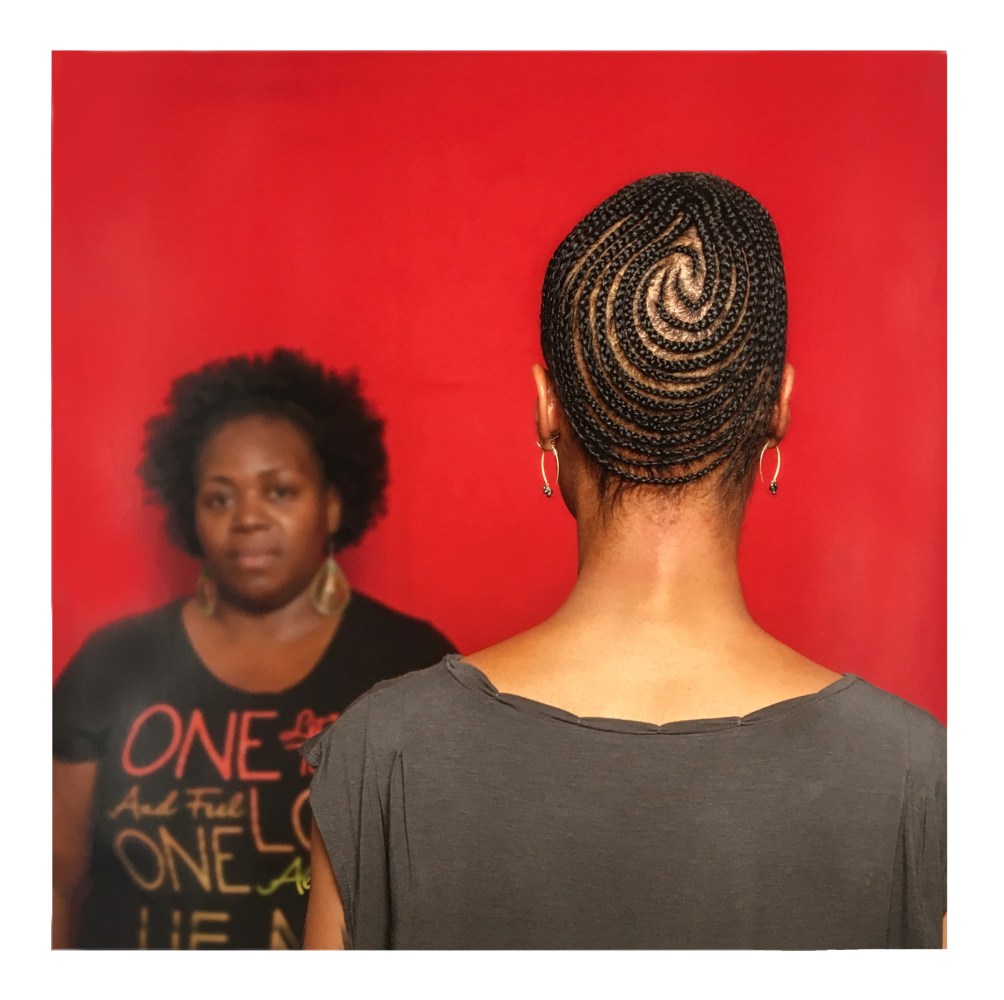
Hair Craft Project with Chaunda, 2014
Pigment print on archival paper
29 x 29 in. (73.7 x 73.7 cm)
Edition of 10
Clar-1021-C
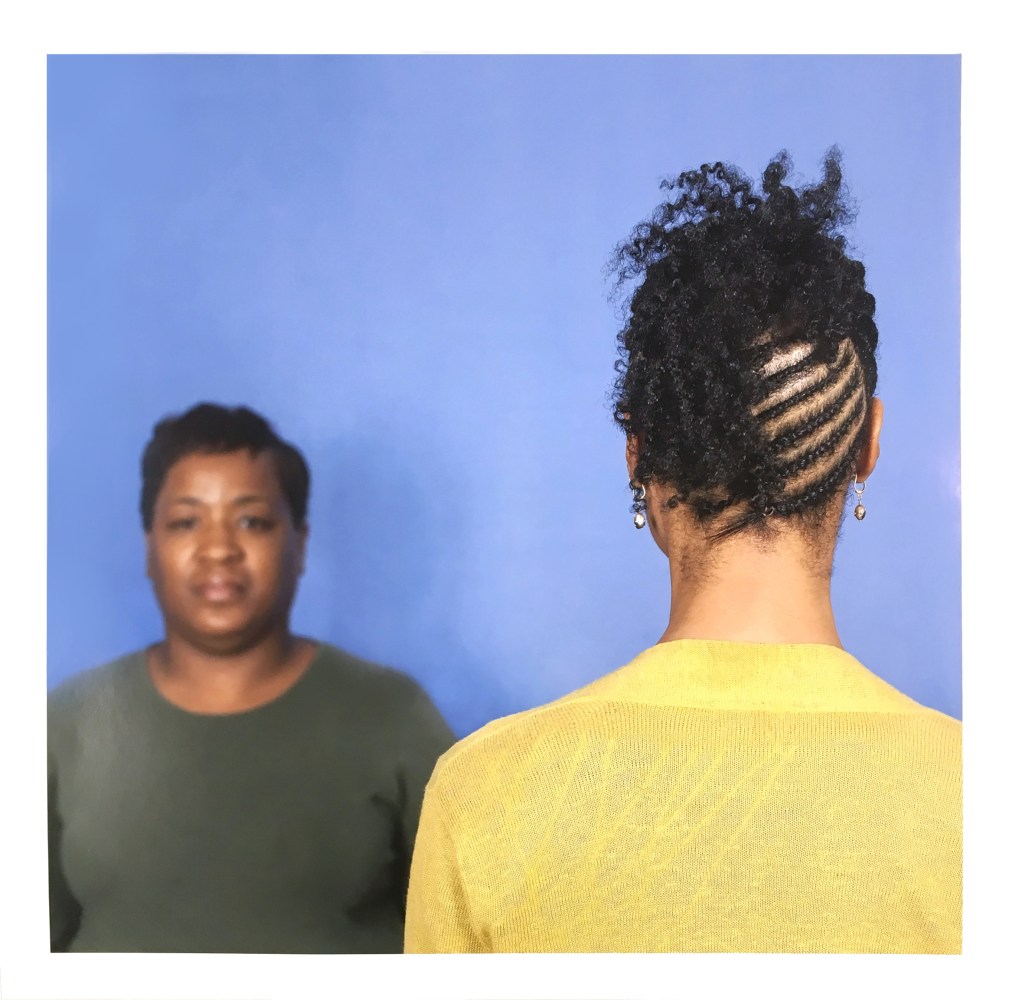
Hair Craft Project with Marsha, 2014
Pigment print on archival paper
29 x 29 in. (73.7 x 73.7 cm)
Edition of 10
Clar-1020-C
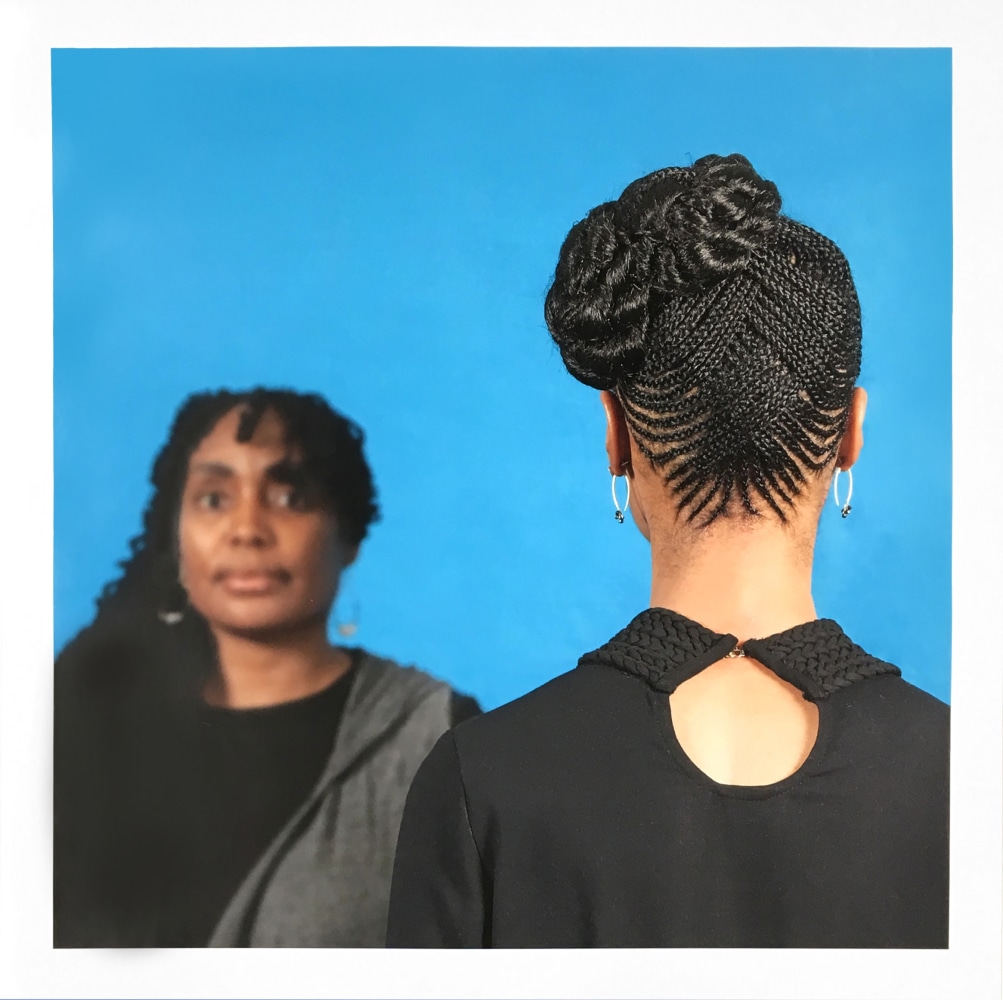
Hair Craft Project with Dionne, 2014
Pigment print on archival paper
29 x 29 in. (73.7 x 73.7 cm)
Edition of 10
Clar-1019-C
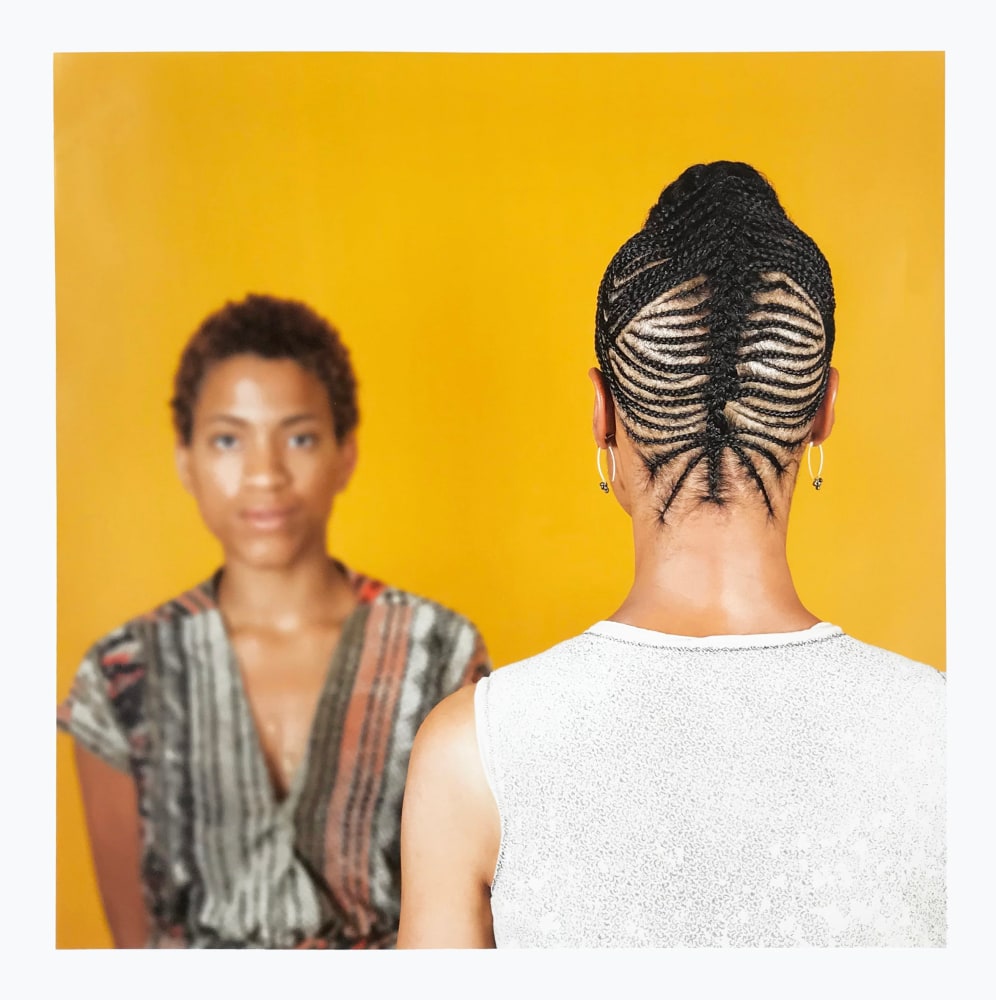
Hair Craft Project with Kamala, 2014
Pigment print on archival paper
29 x 29 in. (73.7 x 73.7 cm)
Edition of 10
Clar-1018-C
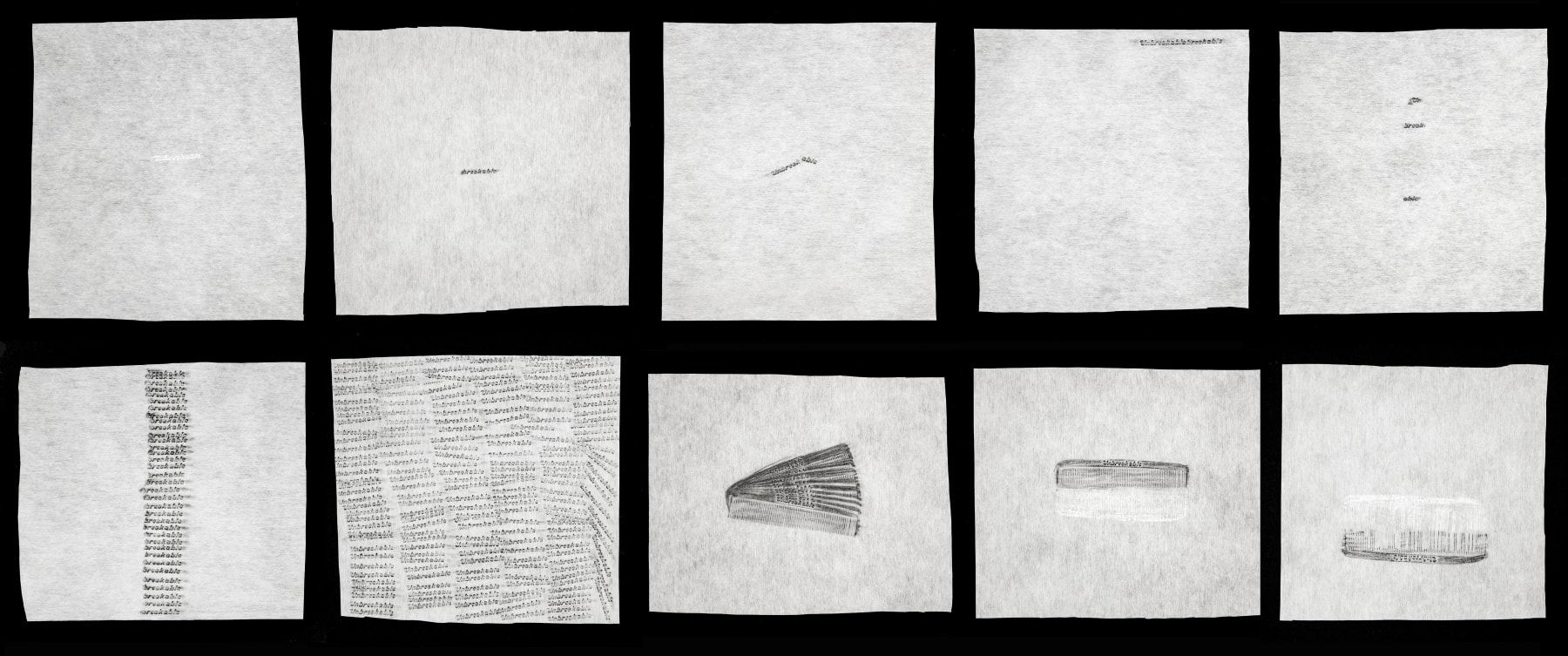
Unbreakable, 2014
Oil stick rubbing on polyester
12 x 12 in. (30.5 x 30.5 cm)
Clar-1016-C
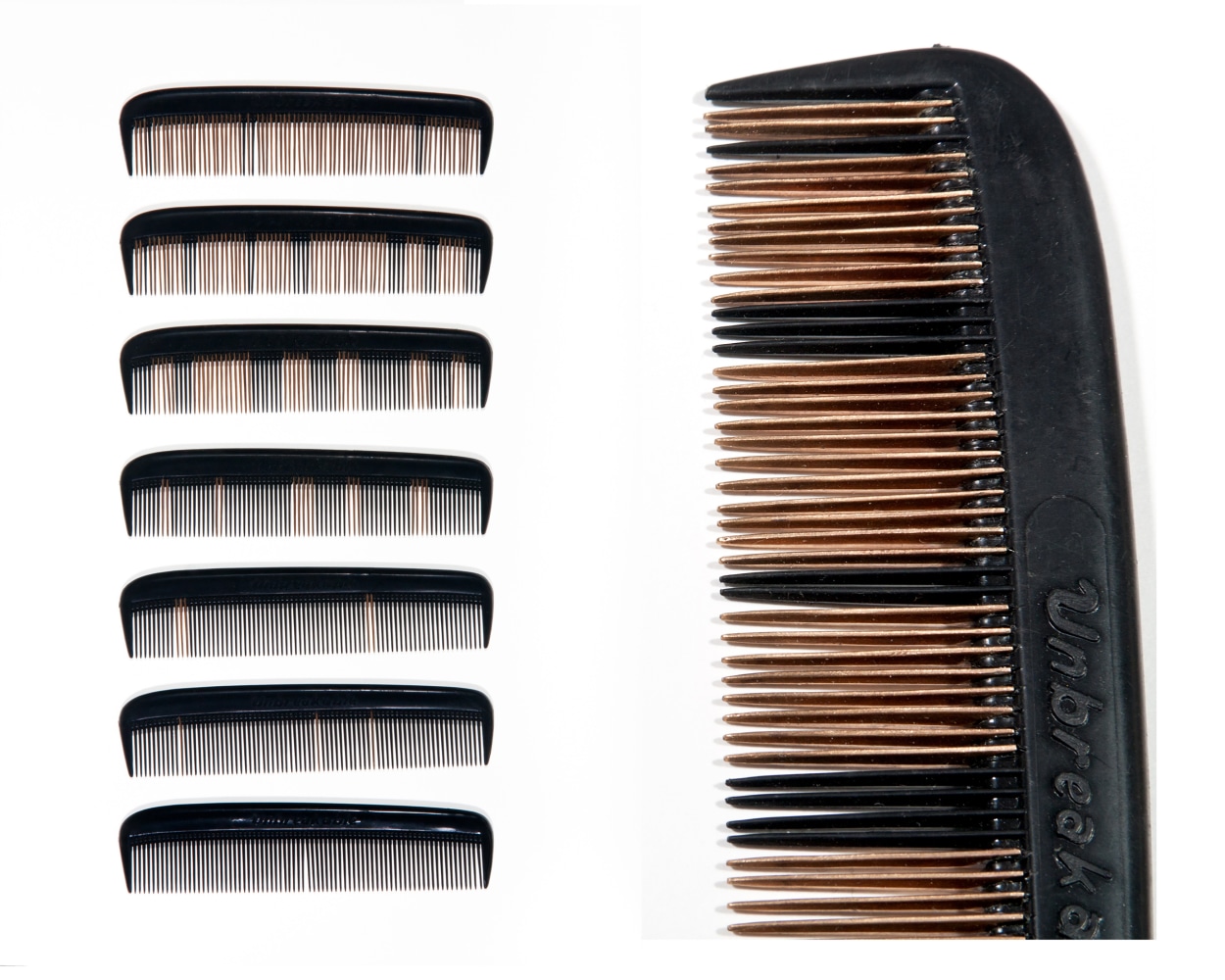
Gold Teeth, 2008
Cast plastic combs, cast bronze
Set of 7, each: 5.5 x 1 in. (14 x 2.5 cm)
Clar-1008-C
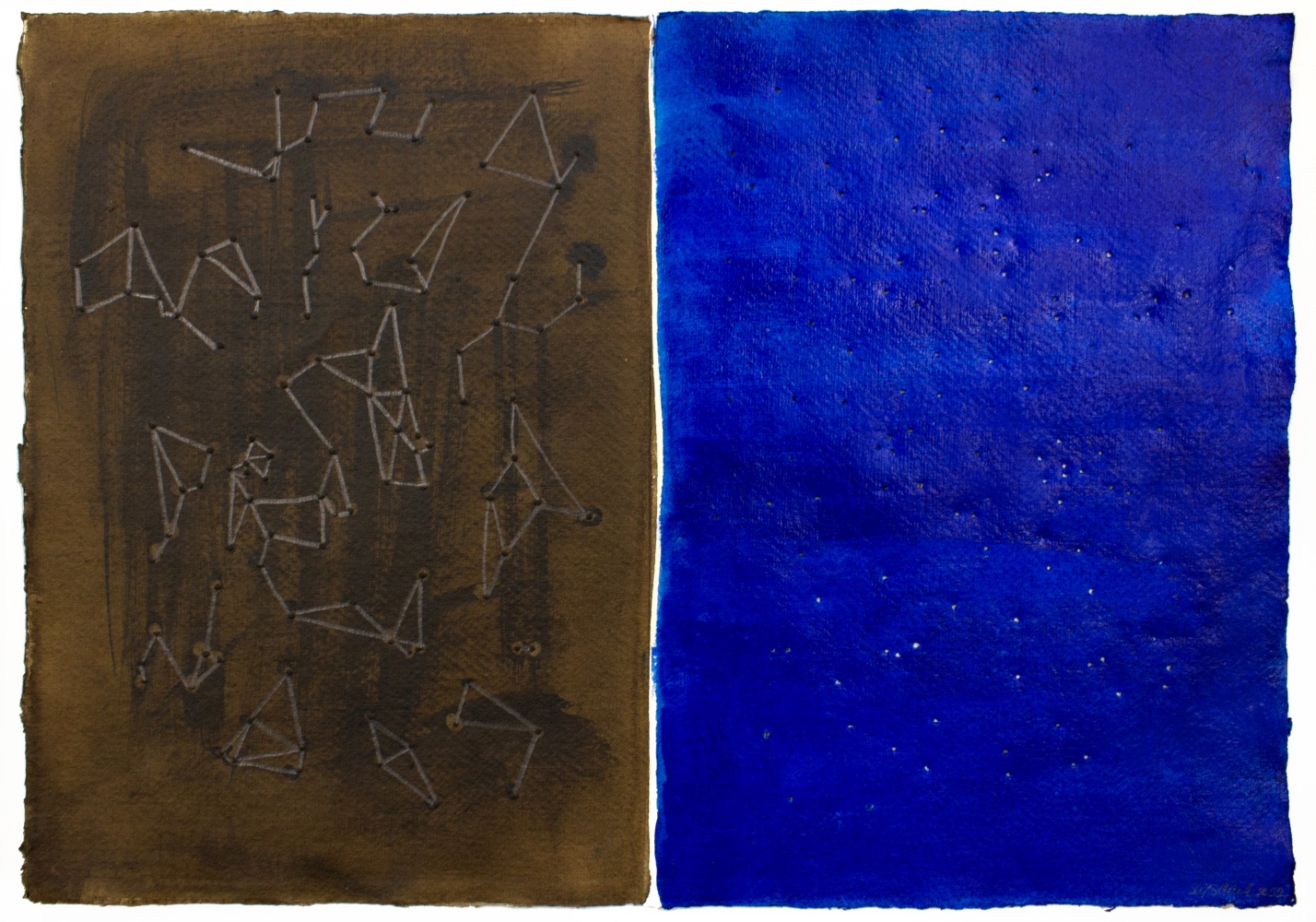
Our Constellations Ourselves, 2022
Mixed media, graphite, and hand puncturing on paper
11.5 x 16.5 in. (29.2 x 41.9 cm)
Clar-1068-C

A River That Forgets Its Source Dries Up, 2008
Mixed media on hand cut paper
15 x 11 in. (38.1 x 27.9 cm)
Private Collection
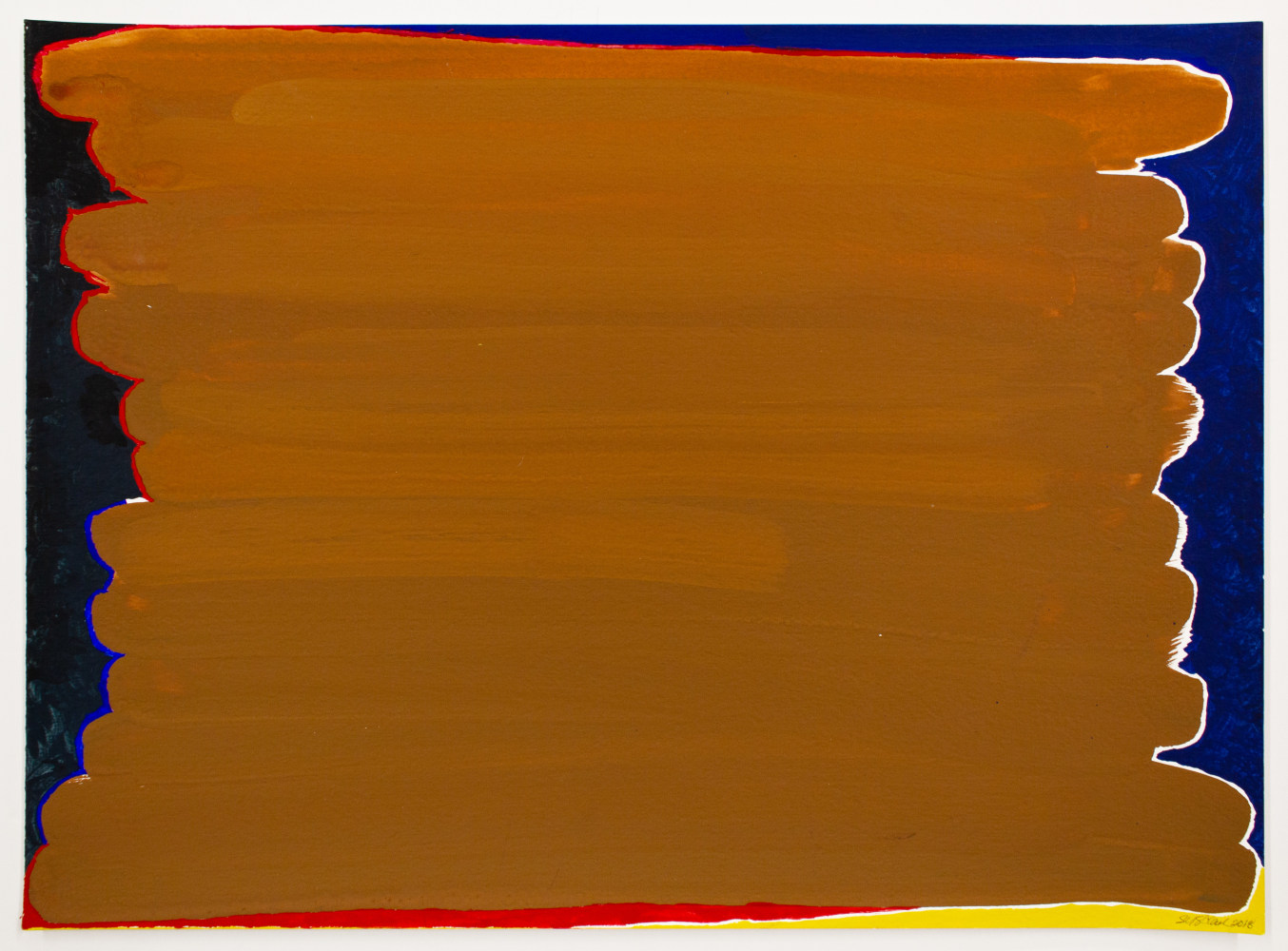
Minding Edges, 2018
Gouache on paper
11 x 15 in. (27.9 x 38.1 cm)
Clar-1066-C
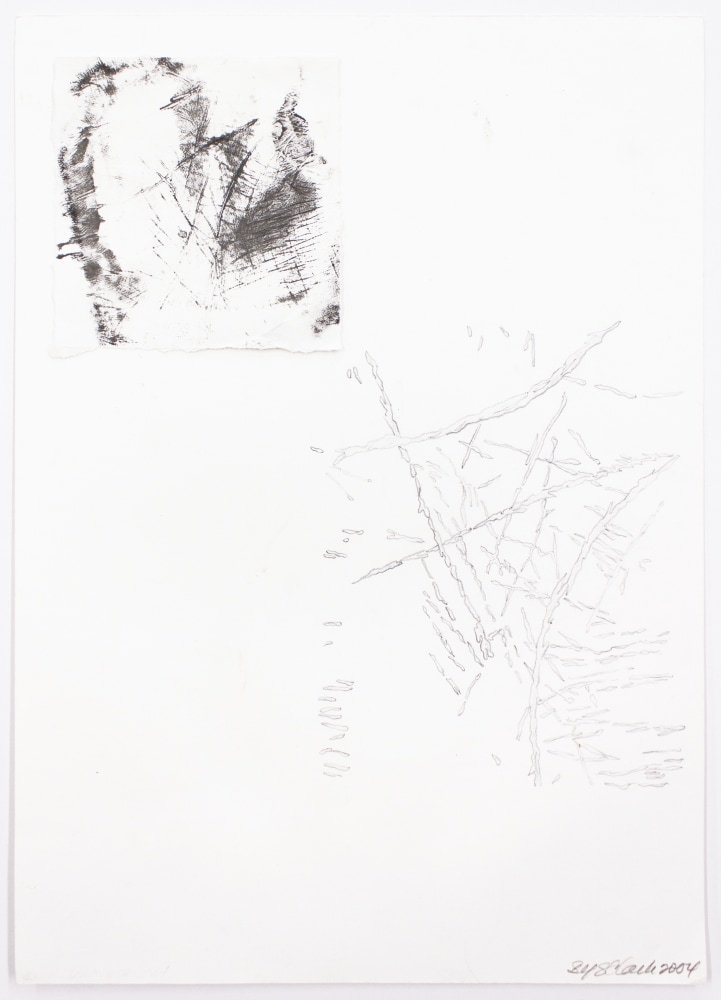
Palm Maps, 2004
Graphite, inked hand stamp, and collage on paper
10.5 x 7.5 in. (26.7 x 19.1 cm)
Clar-1065-C
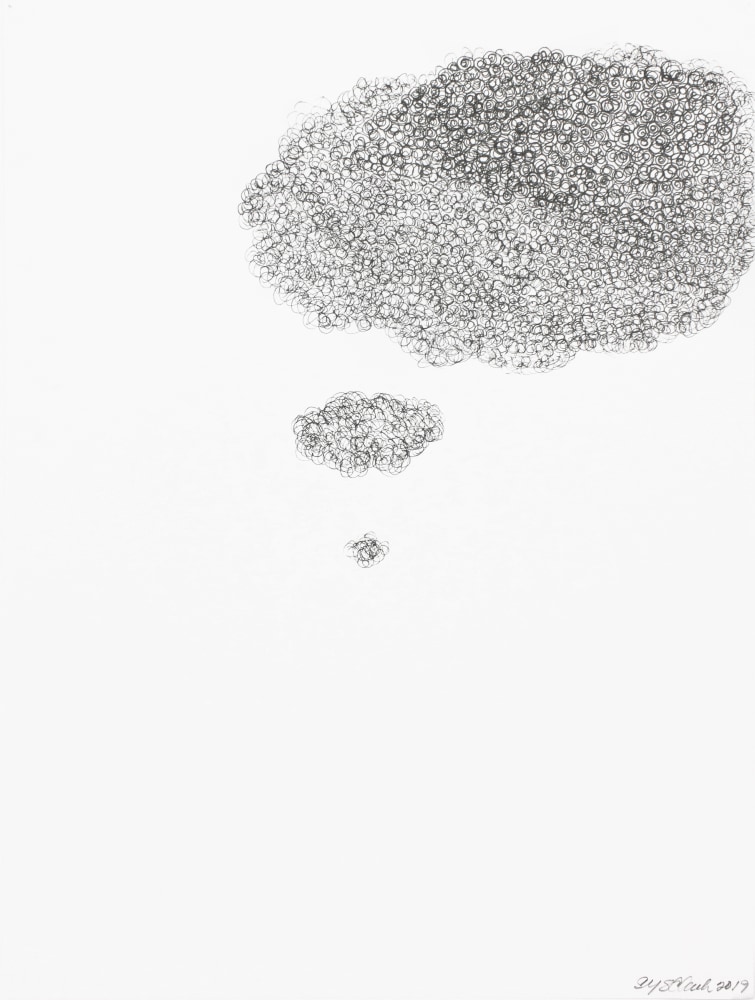
Conceiving Language, 2019
Ink on paper
12 x 9 in. (30.5 x 22.9 cm)
Clar-1064-C
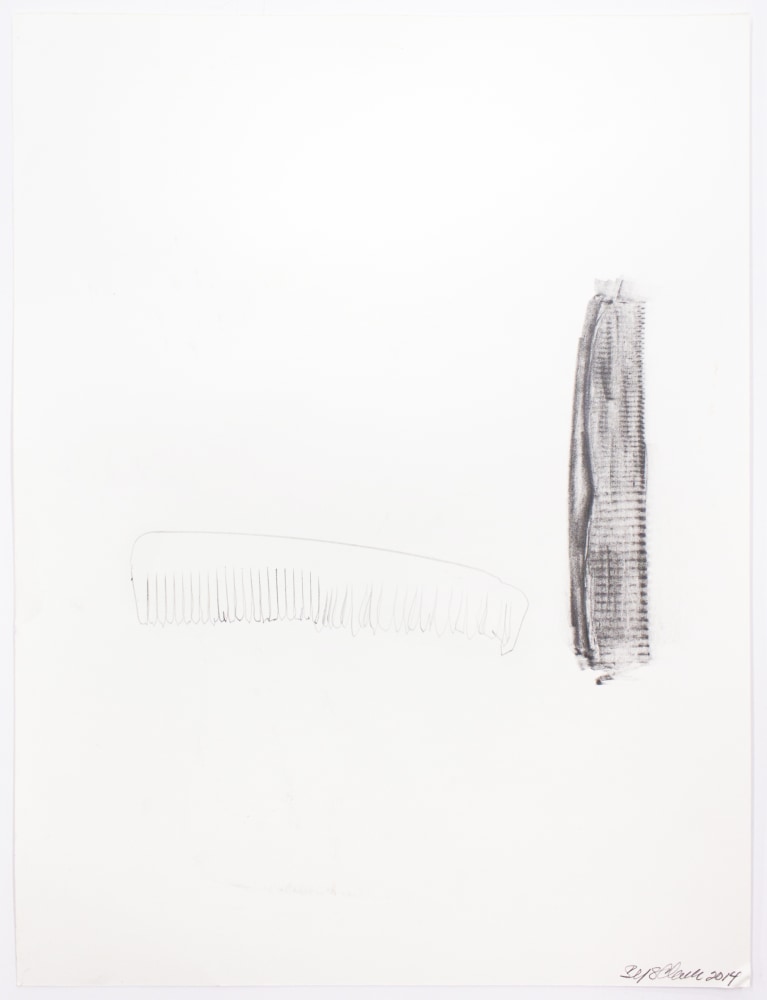
Traced and Rubbed, 2014
Graphite on paper
12 x 9 in. (30.5 x 22.9 cm)
Clar-1063-C





























